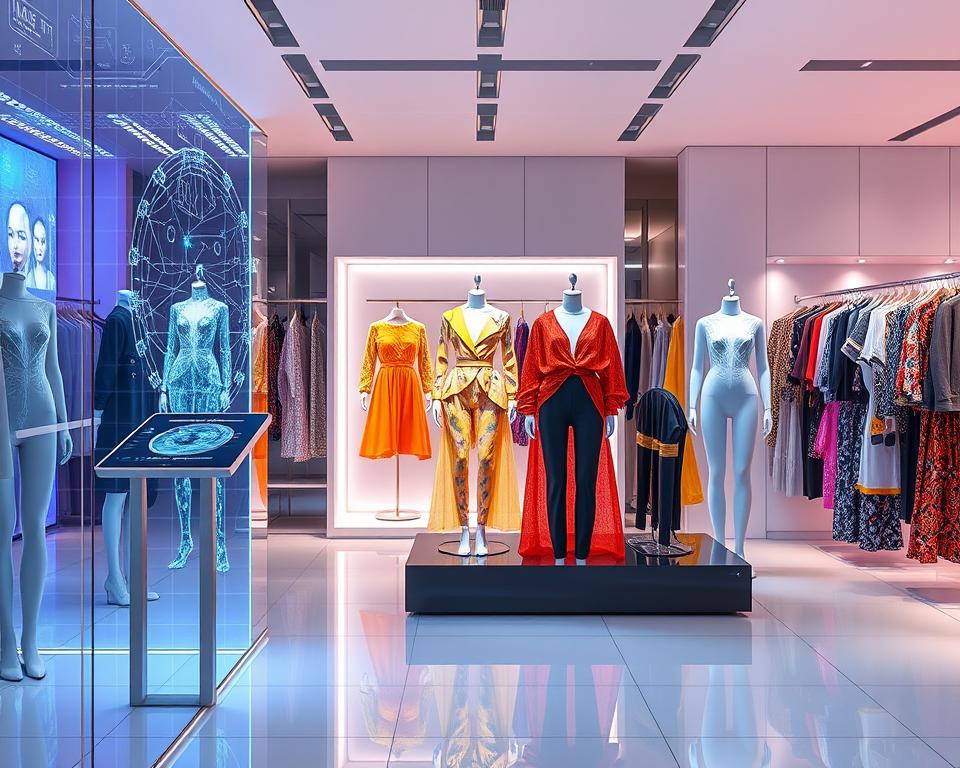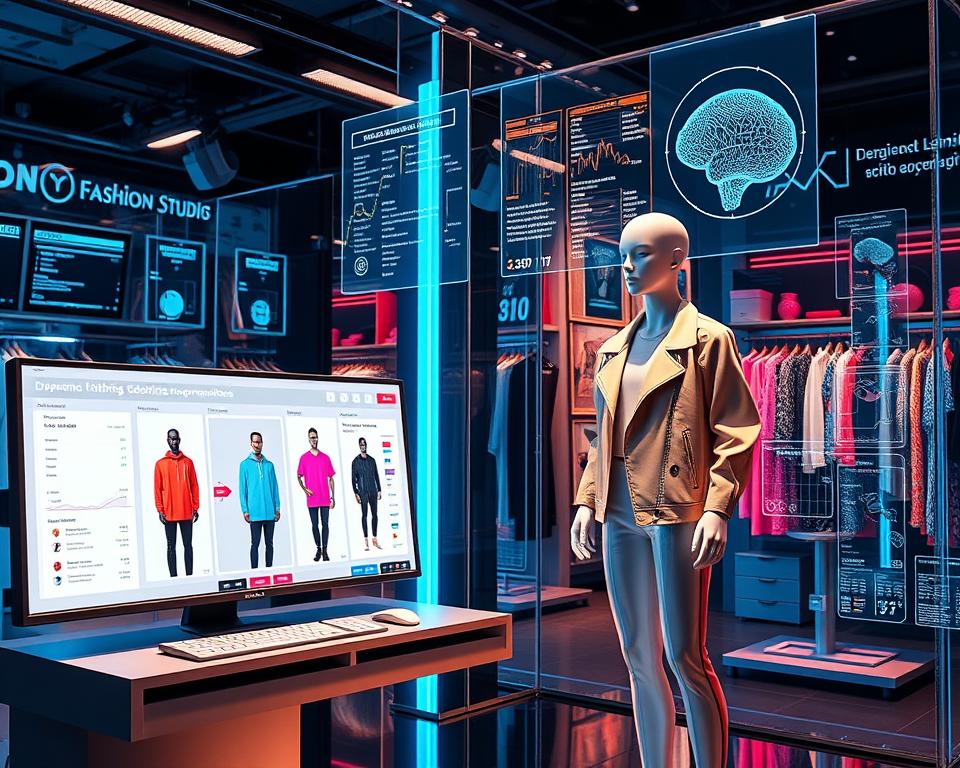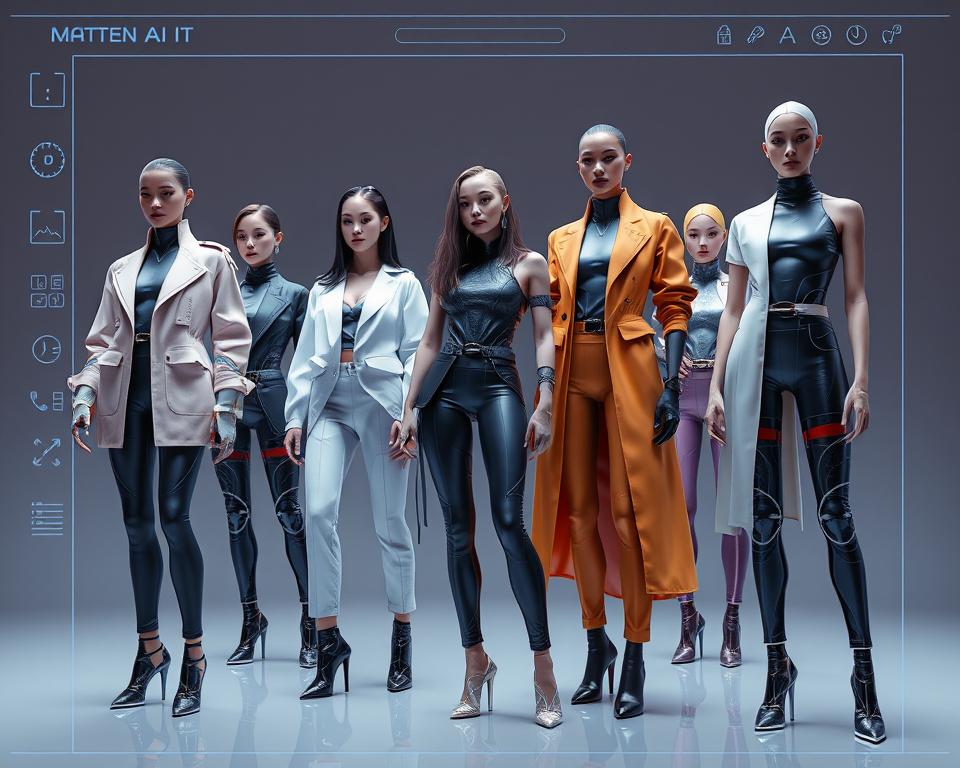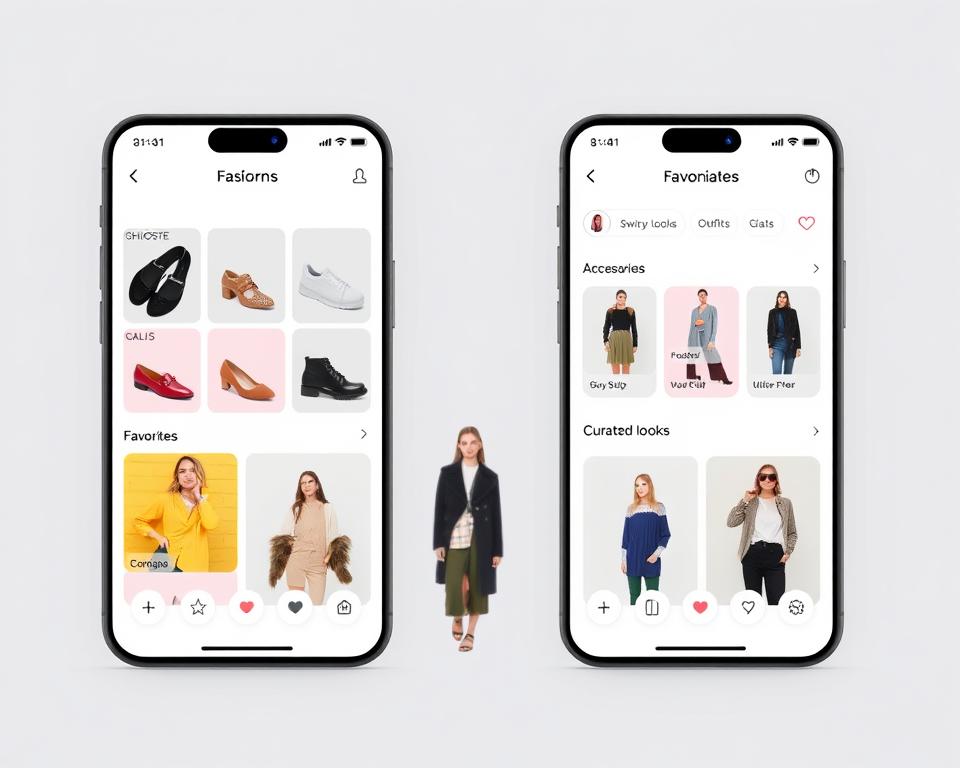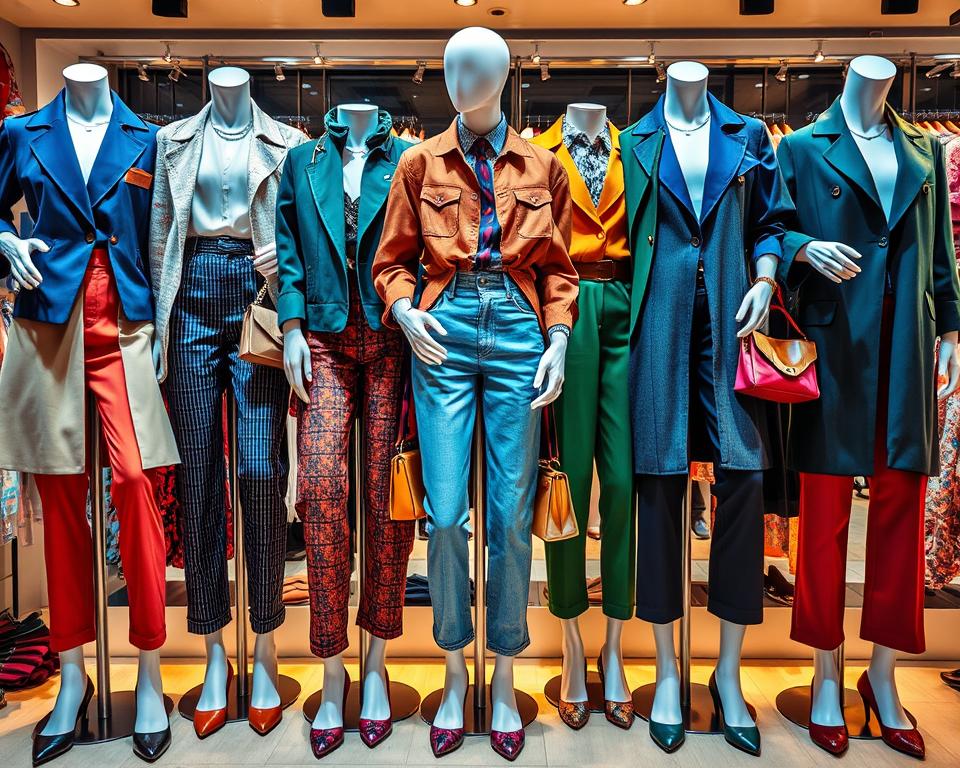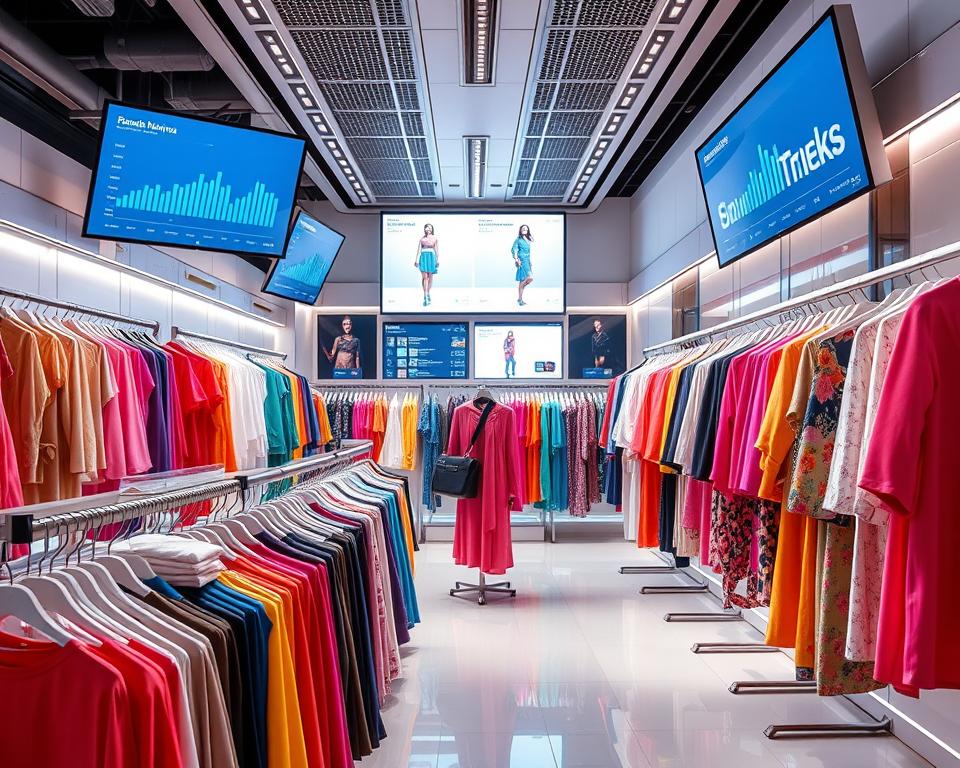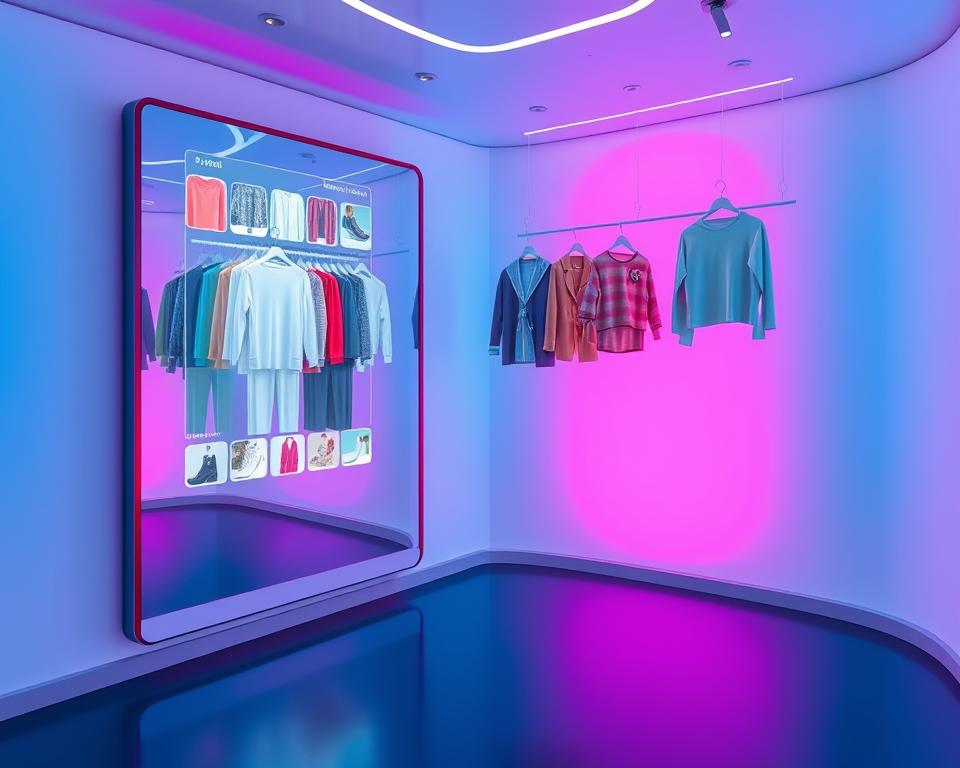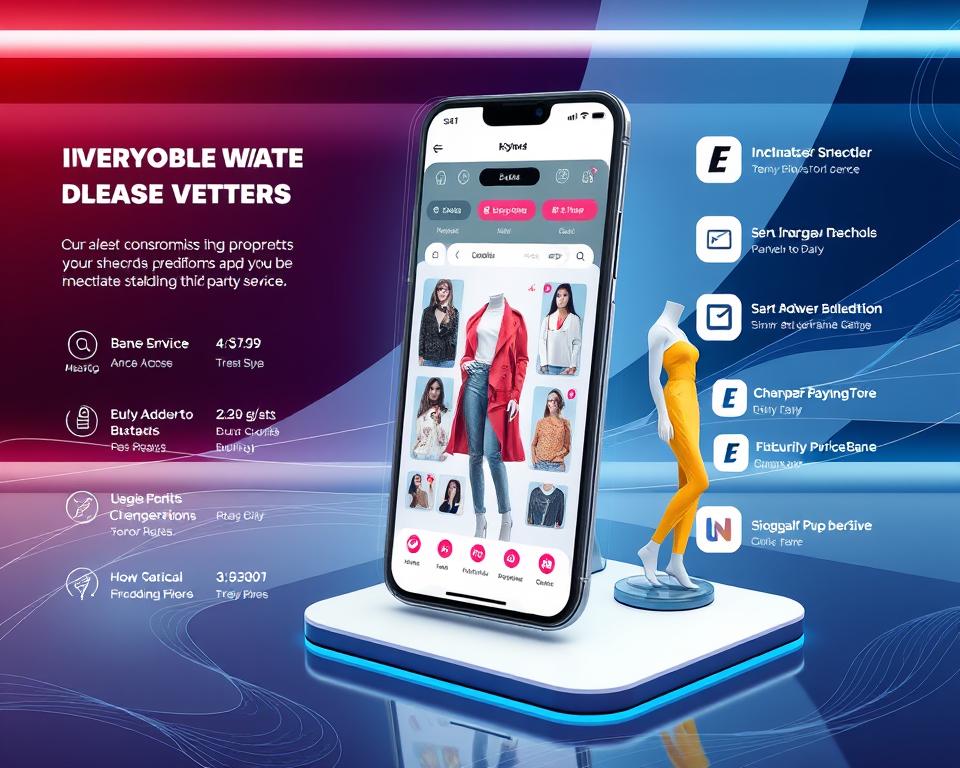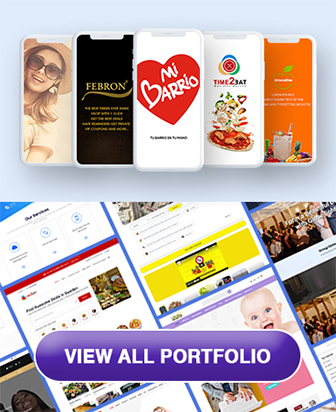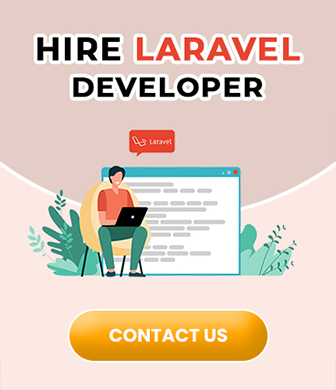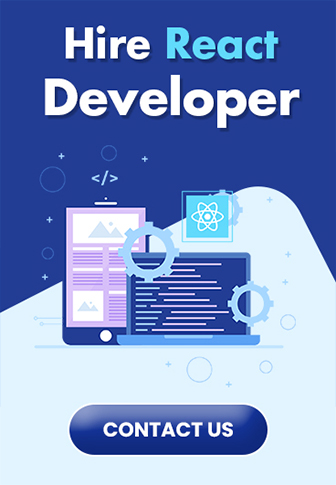The world of fashion is changing fast, thanks to artificial intelligence (AI) and technology. AI-driven fashion apps are now key players. They use data, machine learning, and computer vision to change how we style and shop.
These apps give us personalized styling tips, let us try on clothes virtually, and help manage our wardrobes. They learn our style, body shape, and fashion trends. This makes shopping easier and lets us try new things, boosting our confidence and self-expression.
AI in fashion apps also helps us manage our wardrobes better. They recognize patterns and learn our style preferences. They suggest outfits, find missing pieces, and recommend new clothes that fit our style.
The fashion industry is growing, and AI apps are leading the way. They make styling, shopping, and wardrobe management easier and more fun. AI is bringing a new era of personalized and enjoyable fashion experiences.
Table of Contents
Key Takeaways
- AI-driven fashion apps offer personalized styling recommendations and virtual try-on experiences.
- These applications leverage machine learning and computer vision to analyze user preferences and provide tailored suggestions.
- Smart wardrobe management systems powered by AI help users organize their closets and optimize their outfits.
- The integration of AI in fashion apps is transforming the way we approach personal styling, shopping, and wardrobe management.
- AI-driven fashion applications are poised to revolutionize the fashion industry by delivering personalized, efficient, and enjoyable experiences.
Understanding the Evolution of Fashion Technology Apps
The fashion world has changed a lot, moving from simple digital catalogs to advanced AI fashion apps. These apps change how we shop for clothes. They offer personalized styles based on what we like and our body type.
Traditional Fashion Apps vs AI-Powered Solutions
Older fashion apps were just online stores. But now, AI fashion apps use smart tech to give us style tips. They look at what we like and our body shape to suggest outfits.
Key Milestones in Fashion Tech Development
- Virtual try-on features let us see clothes on ourselves.
- Augmented reality (AR) shows how clothes fit in our space.
- Deep learning helps find the best styles for us.
Current Market Demands and Trends
Today, people want shopping experiences that are personal and fun. Fashion apps now use AI to offer custom advice and try-ons. They aim to make shopping better and more enjoyable.
Core Technologies Behind AI Fashion Applications
The rise of AI fashion apps is thanks to new technologies. These apps use machine learning, computer vision, and natural language processing. They help give users style tips and make shopping easy.
Machine learning is key. It lets apps learn from lots of data. This way, they can suggest clothes that fit your style.
Computer vision is important too. It helps apps see and understand clothes. They can spot trends and suggest matching outfits.
Natural language processing makes apps talk like humans. They can give advice and find new clothes based on what you say.
Behind it all is data analytics. Apps use big data to learn and get better. They find trends and improve their style suggestions.
| Technology | Application |
|---|---|
| Machine Learning | Personalized product recommendations, style preference learning |
| Computer Vision | Fashion item recognition, virtual try-on, trend analysis |
| Natural Language Processing | Conversational styling advice, natural language-based product search |
| Data Analytics | Trend forecasting, personalization algorithm refinement |
AI fashion apps are changing how we shop for clothes. They use new tech to make finding and buying clothes easier and more fun.
Machine Learning Models for Fashion Recognition
Fashion AI technology is growing fast. Machine learning models are key for spotting fashion trends and giving personalized advice. These smart algorithms can understand visual data, find fashion trends, and suggest what you might like.
Computer Vision in Fashion Detection
Convolutional neural networks (CNNs) are a big deal in fashion AI and image recognition. They’re great at finding visual details like textures and colors. This helps them identify and sort out different fashion items very well.
By using lots of labeled fashion pictures, CNNs get better at recognizing all sorts of clothes and accessories. They’re very accurate.
Deep Learning for Style Analysis
Deep learning models are also key for style classification. They use special techniques to understand what you like in fashion. This lets fashion apps give you style tips that really fit your taste.
Pattern Recognition Algorithms
Pattern recognition algorithms are important too. They help find out what’s popular in fashion by looking at lots of data. This includes sales, social media, and what people say about clothes.
By finding these trends, fashion brands can make better choices. They can offer products that people really want. This makes shopping more fun and relevant for everyone.
| Machine Learning Model | Key Capabilities | Example Applications |
|---|---|---|
| Convolutional Neural Networks (CNNs) | Accurate fashion item detection and classification | Virtual try-on, personalized recommendations |
| Deep Learning Techniques | Sophisticated style analysis and preference learning | Wardrobe management, outfit generation |
| Pattern Recognition Algorithms | Trend identification and consumer behavior insights | Product curation, marketing strategy |
“The integration of fashion AI, image recognition, and deep learning models has transformed the way we approach fashion technology and personalization.”
User Experience Design for Fashion Apps
In the fast-paced world of fashion tech, user experience (UX) design is key. It makes apps stand out and keeps users coming back. A good app is easy to use, looks great, and works smoothly.
Good UX/UI design focuses on a few important things:
- Intuitive Navigation: It’s vital to make the app easy to use. Users should find what they need quickly and easily.
- Visual Aesthetics: Fashion apps need to look as good as the clothes they show. They should have clean designs and high-quality pictures.
- Personalization: Adding features that fit the user’s style makes the app more enjoyable. It shows the app cares about what the user likes.
- Responsive Design: The app should work well on all devices. This ensures a great experience no matter where you are.
By focusing on these design principles, fashion apps can offer a top-notch shopping experience. This experience keeps users engaged and loyal to the brand.
“Exceptional UX design is the cornerstone of a successful fashion app, transforming the way consumers discover, explore, and engage with the latest trends.”
Implementing Personal Style Algorithms
Fashion technology is changing how we see personal style. At the center are personalized fashion algorithms that learn and grow with us. These style algorithms analyze our wardrobe management to suggest outfit recommendations that match our style.
Style Preference Learning
Understanding what we like in fashion is key. Advanced models use our data to create a style profile. This helps them suggest outfits that fit our taste.
Wardrobe Analysis Systems
- Smart wardrobe systems scan our clothes using computer vision.
- They sort our clothes, noting patterns, textures, and colors. This gives insights into our wardrobe.
- With this info, algorithms suggest new pieces that fit well with what we already have.
Outfit Generation Logic
Creating personalized outfits is the next step. Style algorithms think about weather, occasion, and body type. They make sure we look good and feel confident, no matter the situation.
| Feature | Benefit |
|---|---|
| Personalized style algorithms | Deliver customized fashion recommendations based on individual preferences |
| Wardrobe analysis systems | Provide insights into the user’s existing clothing collection for cohesive styling |
| Outfit generation logic | Curate outfits that consider practical factors like weather and occasion |
“The future of fashion lies in technology that empowers individuals to express their unique style with confidence.”
Data Collection and Processing Strategies
In the fast-paced world of fashion, fashion data analytics are key. They help us understand what customers want, spot new trends, and make smart choices. From tracking app use to analyzing social media, getting and using data is vital for success.
User behavior tracking is a big part of this. It shows how people use fashion apps, what they like, and what they don’t. This info helps improve the app and give users what they want.
Trend forecasting is another area. It uses social media to find out what’s new and popular. By looking at what people talk about online, brands can predict the next big thing.
Adding inventory data to the mix makes things even better. It combines sales, stock, and product details. This helps brands manage their stock, find top sellers, and plan better.
But, data privacy and security are always a top concern. Keeping user info safe and following rules is crucial. This builds trust and keeps customers coming back.
| Data Source | Insights Gained | Key Applications |
|---|---|---|
| User Behavior Tracking | Product preferences, purchasing patterns, pain points | Personalized recommendations, user experience optimization |
| Social Media Analysis | Emerging trends, popular styles, brand sentiment | Trend forecasting, content strategy, marketing campaigns |
| Inventory Data | Best-selling items, stock levels, product attributes | Supply chain optimization, merchandising, product development |
By using a strong data strategy, fashion tech companies can gain lots of insights. This drives innovation, improves the customer experience, and keeps them competitive.
Virtual Try-On Technologies and Integration
The fashion world is changing fast, thanks to virtual try-on tech. Now, users can see how clothes fit on them before buying. This is made possible by augmented reality (AR), 3D garment modeling, and real-time rendering. It makes online shopping feel more real and personal.
Augmented Reality Features
Augmented reality (AR) is a big part of this change. It lets users try on digital clothes over their own images or videos. This way, they can see how clothes fit in real-time. It makes online shopping more fun and helps users choose better.
3D Modeling Capabilities
Fashion apps also use 3D modeling to show clothes accurately. These models fit each person’s body perfectly. This means users can see exactly how clothes will look and feel.
Real-Time Rendering Solutions
For a smooth try-on experience, apps use real-time rendering. This tech shows clothes on users instantly. It uses fast algorithms and powerful GPUs for a realistic feel.
“The integration of virtual try-on technologies has revolutionized the way we shop for fashion online, empowering consumers with the ability to visualize garments in a personalized, immersive way.”
Building Recommendation Engines for Fashion
In the world of fashion apps, giving users personalized AI-driven recommendations is key. These recommendations use advanced methods like collaborative filtering, content-based filtering, and hybrid recommendation systems. They aim to match what each user likes and needs.
Collaborative Filtering looks at how users behave, like what they buy and rate. It finds users who are similar and suggests items they might like. This helps users find new things they might enjoy.
Content-Based Filtering looks at the details of fashion items, like style and color. It suggests items that are similar to what a user has shown interest in. This is great for finding new and unique items.
The best systems use a hybrid approach. They mix both methods to give users very personalized suggestions. This way, they can offer suggestions that are both accurate and relevant to each user’s style.
As fashion tech grows, using these advanced algorithms will set top fashion apps apart. They will be able to give users a shopping experience that is truly their own.
API Integration and Third-Party Services
Fashion apps are getting better by working with other services and APIs. This makes them more useful and fun to use. They can handle payments safely, connect to social media, and link to online stores.
Payment Gateway Integration
It’s important for fashion apps to let users buy things easily and safely. By teaming up with payment gateways, apps can make buying a breeze. This builds trust and helps more people buy things.
Social Media Connectivity
Fashion apps can use social commerce to connect with social media. This lets users share their fashion choices, follow influencers, and buy things right in the app. It makes the app feel like a community and helps it grow.
E-commerce Platform APIs
Working with e-commerce APIs helps fashion apps show the latest products and manage orders. This means users can see what’s available and handle their orders in the app. It makes shopping easy and fun.
| Integration Type | Benefit | Examples |
|---|---|---|
| Payment Gateway | Secure, frictionless checkout | Stripe, PayPal, Apple Pay |
| Social Media | Enhance social commerce and community | Instagram, Facebook, TikTok |
| E-commerce Platforms | Synchronize product data and inventory | Shopify, WooCommerce, Magento |
By adding these fashion app integrations, developers can make apps that are easy to use and fun. This leads to more people using the app, buying things, and making it successful.
Security and Privacy Considerations
The fashion world is getting smarter with AI apps. But, keeping user data safe is now more important than ever. Fashion apps deal with personal info and payment details. So, following data protection rules like GDPR is key.
Developers must make sure user data is protected. They should use strong encryption, multi-factor login, and check their systems often. This helps find and fix security issues before they become big problems.
- Encryption of user data, including payment information and personal preferences
- Secure user authentication mechanisms, such as biometric identification or two-factor authentication
- Adherence to GDPR compliance standards, ensuring the transparent and lawful processing of user privacy
- Regular security audits and vulnerability assessments to proactively address any security concerns
By focusing on fashion app security and data protection, AI fashion apps can earn user trust. This makes the app more reliable and shows it cares about user privacy. It’s a big step towards being a leader in the fashion tech world.
“Protecting user privacy should be a fundamental pillar of any fashion technology application, as customers entrust us with their personal data and style preferences.”
Performance Optimization and Scaling
AI-driven fashion apps are getting more popular. It’s key to make sure they work well and can grow. Developers need to set up cloud infrastructure, balance loads, and manage caches. This helps users have a smooth experience, even when lots of people are using the app.
Cloud Infrastructure Setup
Cloud computing is vital for fashion apps to grow and change. By using a strong cloud platform, developers can scale up or down easily. This means the app can handle more users without slowing down.
Load Balancing Strategies
Smart load balancing is important. It spreads work across many servers or containers. This keeps the app fast and available. Advanced algorithms adjust resources as needed, making the app better.
Cache Management
Caching boosts the app’s speed and scalability. It stores data like images and style tips in a cache. This makes the app quicker, easing the load on the backend. Using in-memory caching and CDNs can make the app faster and use less cloud resources.
| Optimization Technique | Benefits |
|---|---|
| Cloud Infrastructure Setup | Scalability, Adaptability, Auto-Scaling |
| Load Balancing Strategies | Responsiveness, Availability, Dynamic Resource Allocation |
| Cache Management | Improved Performance, Reduced Backend Load, Enhanced User Experience |
By using these strategies, developers can make AI fashion apps better. They stay fast, flexible, and ready for more users in the fashion world.
Testing and Quality Assurance Methods
Creating a successful AI-driven fashion app needs thorough testing and quality checks. These ensure the app is reliable, accurate, and meets user needs. Testing includes various methods, like unit testing and performance testing, to find and fix issues before the app is released.
User acceptance testing is key. It involves getting feedback from users. This lets them try the app and share their thoughts on its usability and overall experience. Early feedback helps developers make the app better for its users.
Performance testing checks how well the app works under heavy use. It looks at how fast the app is and if it can handle lots of users. This ensures the app works smoothly, even when lots of people are using it.
Developers also use unit testing and integration testing. These tests make sure each part of the app works right, alone and together. These steps help find and fix bugs early, making the app more stable and reliable.
By using a detailed testing plan, brands can make AI-driven fashion apps that meet customer needs. These apps are of high quality and satisfy users.
| Testing Method | Purpose | Key Objectives |
|---|---|---|
| User Acceptance Testing | Evaluate user experience and functionality |
|
| Performance Testing | Assess app’s responsiveness and scalability |
|
| Unit Testing | Validate individual components and functionality |
|
| Integration Testing | Verify integration and interoperability of components |
|
“Comprehensive testing is the hallmark of a well-designed fashion app, ensuring a seamless user experience and a competitive edge in the market.”
Monetization Strategies for Fashion Apps
The fashion tech world is growing fast, and new fashion app revenue models are key for apps’ success. These include in-app purchases, subscription services, affiliate marketing, and partnerships. Fashion apps use many ways to make money and keep users interested.
The freemium model is popular. It lets users try basic features for free and then pay for more. This way, apps can get lots of users and make money from those who upgrade.
In-app purchases are another big money-maker. Apps sell virtual items, styling tips, or special content for a price. This meets users’ needs for personal touches and brings in extra cash.
Fashion apps also team up with online shops and brands through affiliate marketing. They make it easy to buy products right from the app. This way, they get a cut of the sales, helping everyone involved.
As the fashion tech world keeps growing, apps need to mix different ways to make money. By offering free and paid features, in-app buys, and partnerships, they can use their AI to the fullest. This way, they give great value to their users.
Conclusion
The fashion world is changing fast, and AI-driven apps are leading the way. This article looked at how these apps use technology to offer personalized fashion advice. It also talked about how they improve the shopping experience online.
These apps use AI to understand what you like and what you already own. They also let you try on clothes virtually. This makes shopping online much better.
As more people want personalized fashion advice, the industry is set for big changes. We can expect even more cool future of AI fashion and digital styling trends.
Looking to the future, new fashion tech innovations will change how we find and show our style. AI and data will help fashion apps offer even more tailored advice. This will meet the changing needs of fashion lovers everywhere.







